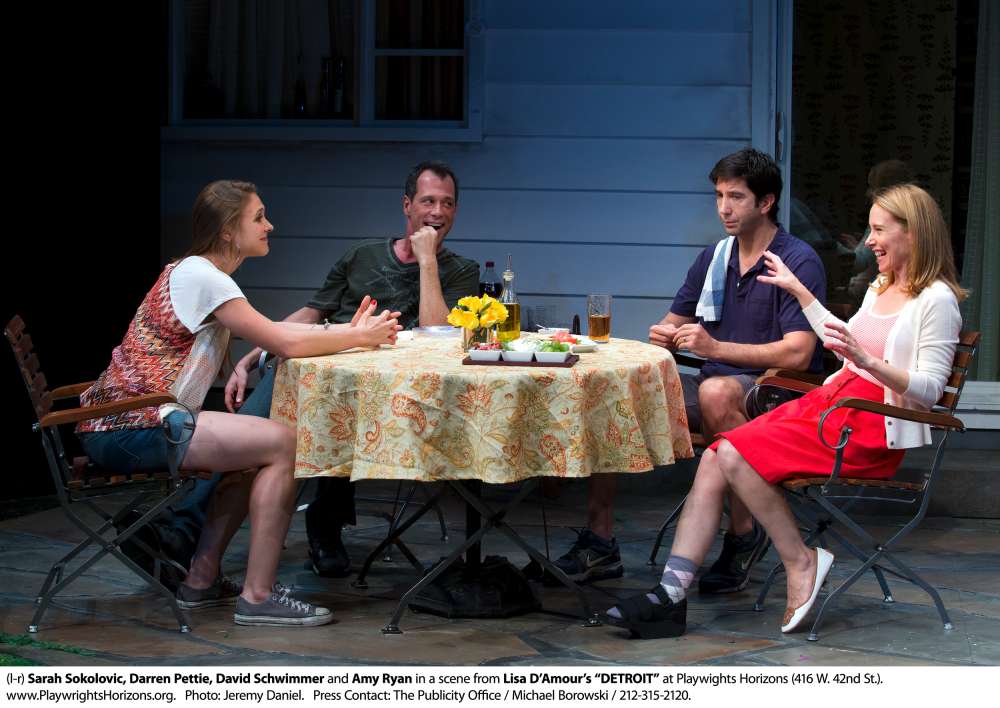Letting Go

“Anyone whose goal is ‘something higher’ must expect someday to suffer vertigo. What is vertigo? Fear of falling? No. Vertigo is something other than fear of falling. It is the voice of the emptiness below us which tempts and lures us; it is the desire to fall, against which, terrified, we defend ourselves.”
– Milan Kundera, The Unbearable Lightness of Being
One of the more compelling new plays I’ve seen recently is Lisa D’Amour’s Detroit, a production of which recently concluded its run at Playwright’s Horizons (directed by Anne Kauffman) but which is surely going to go more places after this. The play revolves around two couples living in a suburban “neighborhood in transition” as they say in the parlance of our time. One couple, Ben (Dave Schwimmer) and Mary (Amy Ryan), is on their way down, socioeconomically speaking. Ben’s been laid off from his job as a loan officer at a bank, and while Mary is still working the couple is only making ends meet because of his severance, and while Ben says he’s working on a website to launch his own small business (providing personal financial planning advice), the evidence of his labor is thin to nonexistent. The other couple, their neighbors Sharon (Sarah Sokolovic) and Kenny (Darren Pettie) is, if not on their way up, at least trying to get on their feet. Sharon and Kenny, we quickly learn, met in rehab a few months before, and are squatting in a relative’s house, but they are both employed and eager to begin building a proper life together.
Or so they say, anyway. As the days go by it becomes increasingly clear that, for both couples, the force of gravity is stronger than any lift they can generate. While Ben and Mary nominally have it “together,” there’s only the thinnest line separating their comfortable bourgeois existence from flat-out destitution. Mary drinks heavily, and Ben speaks of entire days, even weeks vanishing without his knowing what he’s done with them. Literal and metaphorical cracks in the facade of their house open in the very first act, as their sliding door won’t close properly and their patio umbrella collapses on their guests. It seems at first like Kenny and Sharon will prove to be exactly the neighbors Mary and Ben need, and vice versa. Ben and Mary’s respectability will rub off on the eager-to-reform recovering addicts, while Kenny, with his construction skills, will fix the sliding door, and Sharon will help Mary confront her incipient alcoholism. Ben and Mary need friends they can relax with, without so much fear about keeping up appearances; Kenny and Sharon need the right sort of friends, who will reinforce their best instincts rather than their worst.
But this happy narrative depends on a material basis that is nonexistent. Kenny may have worked in construction, but his skills prove questionable when the deck he’s building collapses. Neither he nor Sharon can stay on the wagon. Then he gets laid off, for reasons that, as he articulates them, don’t make much sense. Meanwhile, Mary and Ben grow more and more reliant on their new friends for emotional support and connection, as it becomes clearer and clearer to them that they are going to lose the socioeconomic position that they have, sooner or later. And, as Macbeth said of the murder, if it were done when ’tis done, twere well it were done quickly. And so they are increasingly tempted to cut loose from the bonds of respectability and responsibility that have been tightening around their necks, and enter into fantasy existences with their new friends, whether of living in the wilderness, or opening up their marriage, or, in the end, literally setting their lives ablaze.
The language that Ben and Mary use – of plans, and goals, and directed activity – is like the bamboo airstrips of a cargo cult. They know that once this kind of talk brought prosperity, but though they keep talking they feel themselves slipping away. And their only joy comes from finally letting go, letting it all go, and falling free.
At the end of the play, Ben and Mary learn that Kenny and Sharon were not what they presented themselves as at the start. Perhaps they were fooling themselves and perhaps they were trying to fool Ben and Mary, but Kenny and Sharon were always living from moment to violent moment. But even as they survey the wreckage of their lives, Ben and Mary don’t really blame Kenny and Sharon. They liked them. With them, they experienced the only kind of freedom they were ever likely to feel.
I haven’t said much about this excellent production, because it’s closed. Briefly, I thought the standout performance was Darren Pettie’s Kenny – I was convinced at the beginning that this was a decent blue-collar guy and at the end that he was a spirit of anarchy come to earth, and I believed that these were the same person all the way through – but both Amy Ryan and Sarah Sokolovic gave powerful and moving performances. The revolving set, by Louisa Thompson, was surprisingly operatic for such a simple play and such a small space, but it was worth it for the final effect.
But this play will unquestionably have many future productions, at many different scales. If one is mounted in your community, go see it.
Comments